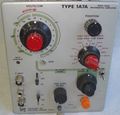1A7: Difference between revisions
No edit summary |
No edit summary |
||
| Line 18: | Line 18: | ||
* [http://w140.com/mmm/tek-1a7.pdf Tektronix 1A7 Manual (PDF)] | * [http://w140.com/mmm/tek-1a7.pdf Tektronix 1A7 Manual (PDF)] | ||
* [http://w140.com/tek_1a7a.pdf Tektronix 1A7A Manual (PDF)] | * [http://w140.com/tek_1a7a.pdf Tektronix 1A7A Manual (PDF)] | ||
<gallery> | |||
File:Tek 1a7a 1.JPG|1A7A | |||
File:Tek 1a7a 2.JPG|1A7A | |||
File:Tek 1a7a 3.JPG|1A7A | |||
File:Tek 1a7a 4.JPG|1A7A | |||
File:Tek 1a7a 5.JPG|1A7A | |||
File:Tek 1a7a 6.JPG|1A7A | |||
</gallery> | |||
Revision as of 15:35, 3 August 2012
Type 1A7 is a high-sensitivity differential plug-in for 500-series scopes. It senses down to 10uV/div, either AC or DC-coupled. It's possible to apply up to +/-300mV offset to the reading while maintaining sensitivity. Upper and lower cutoff frequency is selectable on the front panel. Maximum bandwidth is 500kHz, and common-mode rejection is 50,000 to 1.
Type 1A7's front end is a matched quad of 7586 nuvistors, with two in parallel - to reduce noise - on each input. These tubes are in temperature-equalizing housings, and mounted on a rubber-isolated subchassis. The "coarse" balance adjustment controls the relative heater voltages on the 7586's.
Type 1A7 was introduced in 1966. In 1968 it was superseded by the FET-equipped Type 1A7A, which also doubled the bandwidth and the common-mode rejection. Type 1A7A remained available until the end of the classic plug-in scope line after 1974.
-
1A7A
-
1A7A
-
1A7A
-
1A7A
-
1A7A
-
1A7A





